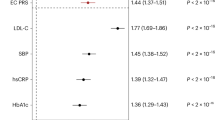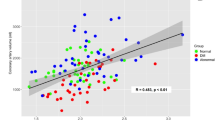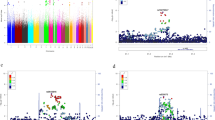Abstract
Paraoxonase-1 (PON1) can protect endothelial function by preventing the oxidation of low-density lipoprotein (LDL) cholesterol and retarding the development of atherosclerosis. We examined whether PON1 polymorphism influences endothelium-dependent coronary vasomotor responses. Sixty-seven patients underwent diagnostic cardiac catheterization, but showed no significant coronary artery stenosis. In all patients, PON1 genotypes (Q/Q, Q/R and R/R) were determined, and provocative testing was performed by the intracoronary administration of graded doses of bradykinin (BK; 0.2, 0.6 and 2.0 μg/min) and acetylcholine (ACh; 3, 10 and 30 μg/min). Coronary blood flow (CBF) was evaluated by a Doppler guide wire. The patients were divided into 2 groups on the basis of ACh testing: one with coronary spastic angina (CSA) and one with non-CSA. The frequencies of the PON1 genotype in the CSA group did not differ significantly from those in the non-CSA group. In the non-CSA group, the patients were subdivided into 2 groups: a group with the Q/Q or Q/R genotypes and a group with the R/R genotype. The vasoconstrictive responses of the epicardial coronary artery to ACh were comparable between the Q/Q + Q/R and R/R groups. Also, the coronary vasodilations induced by BK in the R/R group were similar to those in the QR + QQ group. There were no significant differences in the CBF responses induced by BK or ACh between the Q/Q + Q/R and R/R groups. In conclusion, as estimated by BK and ACh testing, our findings suggest that PON1 genotypes may not play a critical role in the modulation of endothelial vasomotor function in the intact coronary circulation.
Similar content being viewed by others
Article PDF
References
Raitakari OT, Pitkanen OP, Lehtimaki T, et al: In vivo low density lipoprotein oxidation relates to coronary reactivity in young men. J Am Coll Cardiol 1997; 30: 97–102.
Mackness MI, Abbott C, Arrol S, Durrington PN : The role of high-density lipoprotein and lipid-soluble antioxidant vitamins in inhibiting low-density lipoprotein oxidation. Biochem J 1993; 294: 829–834.
Ruiz J, Blanche H, James RW, et al: Gln-Arg192 polymorphism of paraoxonase and coronary heart disease in type 2 diabetes. Lancet 1995; 346: 869–872.
Serrato M, Marian AJ : A variant of human paraoxonase/arylesterase (HUMPONA) gene is a risk factor for coronary artery disease. J Clin Invest 1995; 96: 3005–3008.
Odawara M, Tachi Y, Yamashita K : Paraoxonase polymorphism (Gln192-Arg) is associated with coronary heart disease in Japanese noninsulin-dependent diabetes mellitus. J Clin Endocrinol Metab 1997; 82: 2257–2260.
Quyyumi AA : Prognostic value of endothelial function. Am J Cardiol 2003; 91: 19H–24H.
Ito T, Yasue H, Yoshimura M, et al: Paraoxonase gene Gln192Arg (Q192R) polymorphism is associated with coronary artery spasm. Hum Genet 2002; 110: 89–94.
Bauters C, Amant C, Boullier A, et al: Paraoxonase polymorphism (Gln192Arg) as a determinant of the response of human coronary arteries to serotonin. Circulation 2000; 101: 740–743.
Malin R, Knuuti J, Janatuinen T, et al: Paraoxonase gene polymorphisms and coronary reactivity in young healthy men. J Mol Med 2001; 79: 449–458.
Nakashima M, Mombouli JV, Taylor AA, Vanhoutte PM : Endothelium-dependent hyperpolarization caused by bradykinin in human coronary arteries. J Clin Invest 1993; 92: 2867–2871.
Toda N, Okamura T : Endothelium-dependent and -independent responses to vasoactive substances of isolated human coronary arteries. Am J Physiol 1989; 257: H988–H995.
Yasue H, Horio Y, Nakamura N, et al: Induction of coronary artery spasm by acetylcholine in patients with variant angina: possible role of the parasympathetic nervous system in the pathogenesis of coronary artery spasm. Circulation 1986; 74: 955–963.
Ohira N, Matsumoto T, Tamaki S, et al: Angiotensin-converting enzyme insertion/deletion polymorphism modulates coronary release of tissue plasminogen activator in response to bradykinin. Hypertens Res 2004; 27: 39–45.
Tarutani Y, Matsumoto T, Takashima H, Yamane T, Horie M : Brachial artery flow-mediated vasodilation is correlated with coronary vasomotor and fibrinolytic responses induced by bradykinin. Hypertens Res 2005; 28: 59–66.
Tamaki S, Iwai N, Tsujita Y, Nakamura Y, Kinoshita M : Polymorphism of alpha-adducin in Japanese patients with essential hypertension. Hypertens Res 1998; 21: 29–32.
Tamaki S, Nakamura Y, Tsujita Y, et al: Polymorphism of the angiotensin converting enzyme gene and blood pressure in a Japanese general population (the Shigaraki Study). Hypertens Res 2002; 25: 843–848.
Tamaki S, Nakamura Y, Tabara Y, et al: Combined analysis of polymorphisms in angiotensinogen and adducin genes and their effects on hypertension in a Japanese sample: the Shigaraki Study. Hypertens Res 2005; 28: 645–650.
Matsumoto T, Takashima H, Ohira N, et al: Plasma level of oxidized low-density lipoprotein is an independent determinant of coronary macrovasomotor and microvasomotor responses induced by bradykinin. J Am Coll Cardiol 2004; 44: 451–457.
Tomiyama H, Kushiro T, Okazaki R, Yoshida H, Doba N, Yamashina A : Influences of increased oxidative stress on endothelial function, platelets function, and fibrinolysis in hypertension associated with glucose intolerance. Hypertens Res 2003; 26: 295–300.
Hirooka Y, Eshima K, Setoguchi S, Kishi T, Egashira K, Takeshita A : Vitamin C improves attenuated angiotensin II–induced endothelium-dependent vasodilation in human forearm vessels. Hypertens Res 2003; 26: 953–959.
Zama T, Murata M, Matsubara Y, et al: A 192Arg variant of the human paraoxonase (HUMPONA) gene polymorphism is associated with an increased risk for coronary artery disease in the Japanese. Arterioscler Thromb Vasc Biol 1997; 17: 3565–3569.
Herrmann SM, Blanc H, Poirier O, et al: The Gln/Arg polymorphism of human paraoxonase (PON 192) is not related to myocardial infarction in the ECTIM Study. Atherosclerosis 1996; 126: 299–303.
Antikainen M, Murtomaki S, Syvanne M, et al: The Gln-Arg191 polymorphism of the human paraoxonase gene (HUMPONA) is not associated with the risk of coronary artery disease in Finns. J Clin Invest 1996; 98: 883–885.
Adams MR, Robinson J, McCredie R, et al: Smooth muscle dysfunction occurs independently of impaired endothelium-dependent dilation in adults at risk of atherosclerosis. J Am Coll Cardiol 1998; 32: 123–127.
Mashiba J, Koike G, Kamiunten H, Ikeda M, Sunagawa K : PON1 A632G polymorphism results in amino acid substitution (Q192R) and PON1 with the 632-G allele reduces its antioxidant activity. Circ J 2005; 69: 1466–1471.
Mackness B, Davies GK, Turkie W, et al: Paraoxonase status in coronary heart disease: are activity and concentration more important than genotype? Arterioscler Thromb Vasc Biol 2001; 21: 1451–1457.
Diepgen TL, Geldmacher-von Mallinckrodt M : Interethnic differences in the detoxification of organophosphates: the human serum paraoxonase polymorphism. Arch Toxicol 1986; 9: 154–158.
Roy AC, Saha N, Tay JS, Ratnam SS : Serum paraoxonase polymorphism in three populations of southeast Asia. Hum Hered 1991; 41: 265–269.
Author information
Authors and Affiliations
Corresponding author
Rights and permissions
About this article
Cite this article
Yamane, T., Matsumoto, T., Nakae, I. et al. Impact of Paraoxonase Polymorphism (Q192R) on Endothelial Function in Intact Coronary Circulation. Hypertens Res 29, 417–422 (2006). https://doi.org/10.1291/hypres.29.417
Received:
Accepted:
Issue date:
DOI: https://doi.org/10.1291/hypres.29.417



